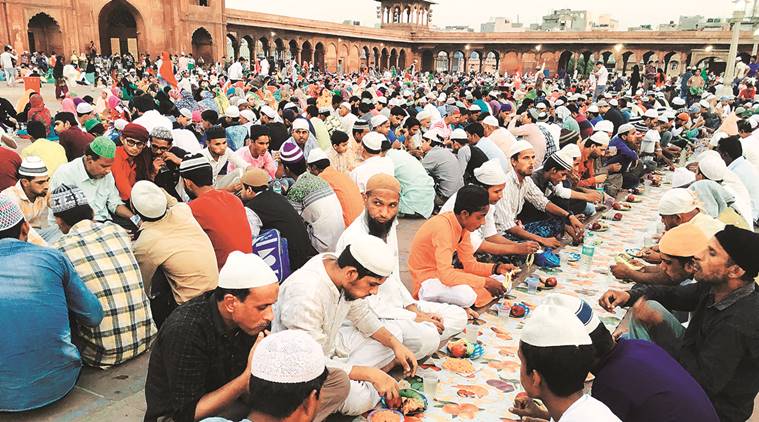 An iftar in progress at Jama Masjid (Express photo by Damini Ralleigh)
An iftar in progress at Jama Masjid (Express photo by Damini Ralleigh)
As the sky grows dim, hundreds of men and women in skullcaps and headscarves spread mats on the courtyard of Jama Masjid, waiting for the Imam to recite the azaan. During the month of Ramazan, considered to be the time that the Qur’an was revealed to Prophet Muhammad, the 17th-century mosque built by Shah Jahan gathers visitors from across the city, who come together to offer prayers and break their day-long fasts, termed rozas, observed by the Islamic world between dusk and dawn. This meal, known as iftar, is typically broken with dates as it is believed that the Prophet ended his fast with them. Purveyors of the fruit circle the mosque. Mahinder Yadav, 52, who is a fixture outside Gate no. 2 of the mosque, deftly packs them for the hoards making their way to it. For him, the most special part of iftar is the lights that are strung along the minarets. “Azaan ke baad raunaq ka mahaul ban jaata hai,” he says.
The pathway up to the mosque is lined with vendors selling sevaiyaan, kebabs, fruits and phirni. Several pick up these delicacies to savour, that they empty into utensils they carry from home. While some begin with lighter victuals like fruits and dahi vada, washed down by sherbet, others dive into heaps of biryani and qorma.
The iftar fare certainly whets the appetite, so we allied with gourmands of varying stripes, put together — and guided — by The Park Hotel’s executive chef, Abhishek Basu, to devour the offerings of Old Delhi’s streets that come alive after the evening prayers. The perennial stream of people in Old Delhi only seems burgeoned at this time and after carefully circumventing muck, rickshaws, stray dogs, cows and their offerings, we landed at the Qureshi Kabab Corner. At this 60-year-old shop, kebabs are grilled at the entrance, luring passers-by. The spice-laden mutton seekhs at the shop come with an additional helping of melted butter and pair well with rumali rotis. Another with a predilection for butter is Aslam Chicken who serves succulent cuts in a pool of melted butter.
For the main course both Karim’s and its neighbour, Al-Jawahar, helpings from cauldrons of boiling and bubbling qorma, choking the air with its aroma, can be paired with biryani and khamiri rotis. For those seeking a taste of nihari, Bilal makes for a good stop. Nihari, here, is served with moti roti. Workers and rickshaw pullers from around the masjid gather at the entrance to stock on food for iftar and the next morning’s sehri.
Among the many that have been serving toothsome dishes in the area for years, growing primarily by word-of-mouth, is Akhil Ahmed, who has been selling gur-ka-sherbet in the area for over 40 years. This isn’t a shop, though. Ahmed perches himself atop a wooden stool with a large vessel with the drink, which is essentially jaggery soaked in water and strained.
The food at Old Delhi is redolent with secrets. The one it revealed to the dozen of us, meandering our way through its labyrinthine alleys, is that it isn’t hard at all to digest our differences.